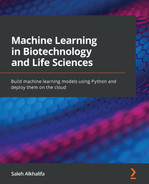Explore all the tools and templates needed for data scientists to drive success in their biotechnology careers with this comprehensive guide The booming fields of biotechnology and life sciences have seen drastic changes over the last few years. With competition growing in every corner, companies around the globe are looking to data-driven methods such as machine learning to optimize processes and reduce costs. This book helps lab scientists, engineers, and managers to develop a data scientist's mindset by taking a hands-on approach to learning about the applications of machine learning to increase productivity and efficiency in no time. You'll start with a crash course in Python, SQL, and data science to develop and tune sophisticated models from scratch to automate processes and make predictions in the biotechnology and life sciences domain. As you advance, the book covers a number of advanced techniques in machine learning, deep learning, and natural language processing using real-world data. By the end of this machine learning book, you'll be able to build and deploy your own machine learning models to automate processes and make predictions using AWS and GCP. This book is for data scientists and scientific professionals looking to transcend to the biotechnology domain. Scientific professionals who are already established within the pharmaceutical and biotechnology sectors will find this book useful. A basic understanding of Python programming and beginner-level background in data science conjunction is needed to get the most out of this book.Key Features
Book Description
What you will learn
Who this book is for
Table of Contents
- Machine Learning in Biotechnology and Life Sciences
- Contributors
- About the author
- About the reviewers
- Preface
- Section 1: Getting Started with Data
- Chapter 1: Introducing Machine Learning for Biotechnology
- Chapter 2: Introducing Python and the Command Line
- Chapter 3: Getting Started with SQL and Relational Databases
- Chapter 4: Visualizing Data with Python
- Section 2: Developing and Training Models
- Chapter 5: Understanding Machine Learning
- Chapter 6: Unsupervised Machine Learning
- Chapter 7: Supervised Machine Learning
- Chapter 8: Understanding Deep Learning
- Chapter 9: Natural Language Processing
- Chapter 10: Exploring Time Series Analysis
- Section 3: Deploying Models to Users
- Chapter 11: Deploying Models with Flask Applications
- Chapter 12: Deploying Applications to the Cloud
- Other Books You May Enjoy
